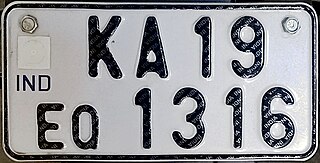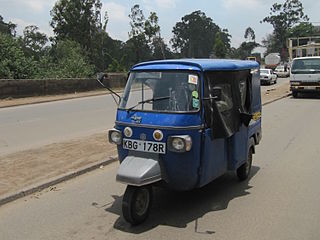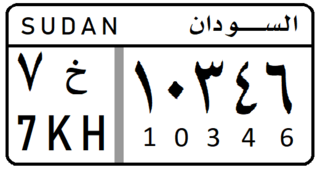South Sudan requires its residents to register their motor vehicles and display vehicle registration plates . [1]
| Image | First issued | Design | Slogan | Serial format | Serials issued | Notes |
|---|---|---|---|---|---|---|
 | 2007 | N/A | Taxi Issued license plate | |||
South Sudan requires its residents to register their motor vehicles and display vehicle registration plates . [1]
| Image | First issued | Design | Slogan | Serial format | Serials issued | Notes |
|---|---|---|---|---|---|---|
 | 2007 | N/A | Taxi Issued license plate | |||

A technical, officially a non-standard tactical vehicle (NSTV) in United States military parlance, is a light improvised fighting vehicle, typically an open-backed civilian pickup truck or four-wheel drive vehicle, mounting a machine gun, anti-aircraft autocannon, rotary cannon, anti-tank weapon, anti-tank gun, ATGM, mortar, multiple rocket launcher, recoilless rifle, or other support weapon.

A vehicle registration plate, also known as a number plate, license plate, is a metal or plastic plate attached to a motor vehicle or trailer for official identification purposes. All countries require registration plates for road vehicles such as cars, trucks, and motorcycles. Whether they are required for other vehicles, such as bicycles, boats, or tractors, may vary by jurisdiction. The registration identifier is a numeric or alphanumeric ID that uniquely identifies the vehicle or vehicle owner within the issuing region's vehicle register. In some countries, the identifier is unique within the entire country, while in others it is unique within a state or province. Whether the identifier is associated with a vehicle or a person also varies by issuing agency. There are also electronic license plates.
SS is an abbreviation for Schutzstaffel, a paramilitary organisation in Nazi Germany.
Australian vehicle registration plates or number plates are issued by state, territory, and Commonwealth governments, and the armed forces of Australia. The plates are associated with a vehicle and are generally intended to last for the time the vehicle remains registered in the state, though as they become unreadable they may be remade with like for like replacement. Motor vehicle registration in Australia, but can be renewed monthly, quarterly, half yearly or annually depending on the state or territory where the vehicle is registered.

All motorised road vehicles in India are tagged with a registration or licence number. The Vehicle registration plate is issued by the district-level Regional Transport Office (RTO) of respective states — the main authority on road matters. The number plates are placed in the front and back of the vehicle. By law, all plates are required to be in modern Arabic numerals with Latin letters. The international vehicle registration code for India is IND.

The Ferret armoured car, also commonly called the Ferret scout car, is a British armoured fighting vehicle designed and built for reconnaissance purposes. The Ferret was produced between 1952 and 1971 by the UK company Daimler. It was widely used by regiments in the British Army, as well as the RAF Regiment and Commonwealth countries throughout the period.
In the United States, vehicle registration plates, known as license plates, are issued by a department of motor vehicles, an agency of the state or territorial government, or in the case of the District of Columbia, the district government. Some Native American tribes also issue plates. The U.S. federal government issues plates only for its own vehicle fleet and for vehicles owned by foreign diplomats. Until the 1980s, diplomatic plates were issued by the state in which the consulate or embassy was located.

The current national emblem of Sudan was adopted in 1985.

The FE-Schrift or Fälschungserschwerende Schrift is a sans serif typeface introduced for use on licence plates. Its monospaced letters and numbers are slightly disproportionate to prevent easy modification and to improve machine readability. It has been developed in Germany where it has been mandatory since November 2000.
South African number plates are unique in each of the provinces. Each province has their own number plate design, colour scheme and alphanumeric scheme. e.g. AB 12 CD GP or CA 123-456
In the United States, the appearance of license plates is frequently chosen to contain symbols, colors, or slogans associated with the issuing jurisdiction, which are the 50 U.S. states, the District of Columbia, the five inhabited U.S. territories, and Native American tribes, each of which independently registers motor vehicles. Regular-issue license plates for passenger vehicles typically have six or seven characters, with vanity plates having up to eight characters in a few states.

The U.S. state of South Carolina first required its residents to register their motor vehicles and display license plates in 1917. As of 2023, plates are issued by the South Carolina Department of Motor Vehicles. Only rear plates have been required since 1975.

The U.S. state of South Dakota first required its residents to register their motor vehicles in 1905. Registrants provided their own license plates for display until 1913, when the state began to issue plates.

Several Native American tribes within the United States register motor vehicles and issue license plates to those vehicles.

The WZ-523 is a six-wheeled Chinese armored personnel carrier designed to be amphibious. Built on the chassis of the Hanyang HY472 truck, it can carry a crew of three and seat up to eight additional passengers. Two primary models were produced—one with a roof-mounted 12.7mm heavy machine gun, and the other with a small turret armed with a 35mm grenade launcher and a 7.62mm co-axial general purpose machine gun. An export model that entered service in 2008 as a fire support vehicle was also marketed successfully to the Namibian Army; this is armed with a 73mm 2A28 Grom smoothbore cannon using the same turret as the Soviet BMP-1 infantry fighting vehicle.

The Sudanese conflict in South Kordofan and Blue Nile was an armed conflict in the Sudanese southern states of South Kordofan and Blue Nile between the Sudanese Army (SAF) and Sudan People's Liberation Movement-North (SPLM-N), a northern affiliate of the Sudan People's Liberation Movement (SPLM) in South Sudan. After some years of relative calm following the 2005 agreement which ended the second Sudanese civil war between the Sudanese government and SPLM rebels, fighting broke out again in the lead-up to South Sudan independence on 9 July 2011, starting in South Kordofan on 5 June and spreading to the neighboring Blue Nile state in September. SPLM-N, splitting from newly independent SPLM, took up arms against the inclusion of the two southern states in Sudan with no popular consultation and against the lack of democratic elections. The conflict is intertwined with the War in Darfur, since in November 2011 SPLM-N established a loose alliance with Darfuri rebels, called Sudan Revolutionary Front (SRF).

The South Sudanese pound is the currency of the Republic of South Sudan. It is subdivided into 100 piasters. It was approved by the Southern Sudan Legislative Assembly before secession on 9 July 2011 from Sudan.

The current series of vehicle registration plates in Kenya are on a white plate with black lettering and look quite similar to UK suffix style registrations. The format is LLL NNNL, where ‘L’ denotes a letter and ‘N’ denotes a digit. The older series of number plates were black with white or silver lettering. Later in the older series the front plates were reflective white with black lettering and the rear plates were reflective yellow with black lettering. According to Kenya National Bureau of Statistics there are over 1,626,380 vehicles in Kenyan road as at 2011.

Sudan requires its residents to register their motor vehicles and display vehicle registration plates.